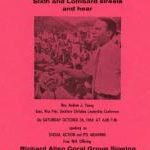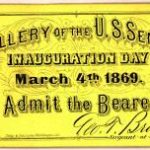Students who listen to this Grade 2 Core Knowledge History and Geography unit discover that Americans had a difficult task at hand after winning the Revolutionary War: they had to figure out a better way to govern themselves. Such leaders as James Madison, George Washington, Alexander Hamilton, and Benjamin Franklin traveled to Philadelphia to meet at the Constitutional Convention, with the goal of creating a new government. Students learn that the talks were held in secret in Independence Hall and that American leaders argued about many issues until they agreed to approve a new Constitution. They then hear that James Madison (whom we call the Father of the Constitution), along with John Jay and Alexander Hamilton, wrote the Federalist Papers to explain the document’s merits and to persuade the states to vote for it. Students find out that the states did finally approve the Constitution; that Madison wrote a Bill of Rights that was added to it; that the Constitution gives the American people the right to decide what the laws should be for our country; and that we can still amend it today.(5 lessons)
Ethics in America II
Eminent leaders explore hypothetical ethical dilemmas in this video series for college and high school classrooms and adult leaders.
Conversations with Leaders in Law
This guide provides resources and potential discussion topics to help bring together law-related community leaders and students.
How a Bill Becomes a Law for AP Gov
A lesson plan for one 80-minute class at the AP level. In it students will identify the main steps in the process of creating and passing legislation:
-Explain the significance of party control and committee work in the Congress in the legislative process
-Identify the role that Congressional leaders such as the House of Representatives and the Senate Majority Leader play in the process of agenda-setting
-Identify the role the President plays in the law-making process
-Explain the reasons why the Founders intended the law-making process to be difficult
Competing Voices of the Civil Rights Movement
When most people think of the Civil Rights Movement in America, they think of Martin Luther King, Jr. delivering his “I Have a Dream” speech on the steps of the Lincoln Memorial in 1963 and receiving the Nobel Peace Prize the following year. But “the Movement” achieved its greatest results — the 1964 Civil Rights Act and the 1965 Voting Rights Act — due to the competing strategies and agendas of diverse individuals. Even black Americans, the primary beneficiaries of this landmark legislation, did not agree on the tactics that should be used to secure the equal protection of their rights. This unit presents the views of several important black leaders who shaped the debate over how to achieve freedom and equality in a nation that had long denied a portion of the American citizenry the full protection of their rights.
Martin Luther King Jr. and the Power of Words
In this lesson students have the opportunity to discuss how words have the power to bring about political, social, or economic change in society. By reviewing quotations from various leaders, activists, and others, students can begin to understand how ideas have an impact on the hearts and minds of people and can be a catalyst for change. Finally, students will reflect on the words of Martin Luther King Jr. and determine their relevance to the political, social, and economic issues of today.
Civil Rights Movement: Sit-Ins
By the 1960s, the Civil Rights movement was growing in the U.S. Leaders such as Martin Luther King Jr. employed non-violent methods of protesting. On February 1, 1960 students in Greenville, NC engaged in a new peaceful tactic, a sit-in. This launched a wave of sit-ins across the country. In this lesson, students will hear about the circumstances that unfolded that day and hits impact on the country.
Civil Rights in Pennsylvania

Throughout the twentieth century, blacks in Pennsylvania employed numerous strategies to achieve the civil rights they deserved. Their efforts for to receive their rights began with a strategy of New Deal liberalism in the 1940s and 50s headed by prominent black leaders. When attempts to rewrite the laws using the established political system failed, black leaders encouraged more direct action, like boycotts and sit-ins. The movement quickly took on a black nationalist approach. Philadelphia became the perfect place for several Black Power conferences and home of the short-lived, though active, Black Panther Party.
Inaugurations: Stepping into History

Discover what inauguration ceremonies over the centuries can teach us about our changing nation and the leaders who have shaped it.
Taking a close look at the moments in which these leaders first took office can provide rich opportunities to investigate the history of the United States as it has changed over the centuries. It can also provide unique insights into these remarkable individuals as they first stepped into history.
Civic Art Project: Considering Leadership
The materials in this curriculum packet are designed to be a classroom resource, a guide to think about the qualities of good leadership, and a creative prompt to create a political poster representing leadership and sharing a vision for the future. Teach your students about elections, help them consider issues that matter to them, and watch as they lend their voices to our national conversation about leadership.